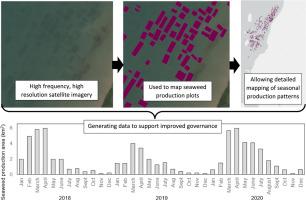Marine Policy ( IF 4.315 ) Pub Date : 2021-02-20 , DOI: 10.1016/j.marpol.2021.104431 Alexandra Langford , Scott Waldron , Sulfahri , Hasnawati Saleh

|
The Indonesian seaweed industry has rapidly expanded over the last twenty years and now contributes to the livelihoods of 267,000 coastal households. Policy makers need accurate information from which to base policy that improves the livelihoods of smallholder farmers without further straining natural resource limits. The sustained growth of the sector necessitates means for reporting and monitoring the sector, particularly in the context of COVID-19. This paper uses newly available, high resolution, high frequency satellite data from April 2017 to December 2020 to identify seaweed farming plots and to map the seasonal changes in the industry. This is overlaid with data on environmental factors, prices, and official production statistics to reveal a range of insights into the industry which are obscured by official annual data, such as the seasonality of production and the change in activity since the beginning of the COVID-19 pandemic. The paper evaluates the usefulness of this data for monitoring the industry and informing strategic policy decisions.
中文翻译:

使用遥感数据监测受COVID-19影响的印度尼西亚海藻行业
在过去的二十年中,印度尼西亚的海藻产业迅速发展,现在为267,000个沿海家庭的生计做出了贡献。决策者需要准确的信息,以此为基础制定能够改善小农户生计的政策,而又不会进一步限制自然资源的限制。该部门的持续增长需要采取手段来报告和监测该部门,特别是在COVID-19的情况下。本文使用2017年4月至2020年12月新近可用的高分辨率高频卫星数据来识别海藻养殖场并绘制该行业的季节性变化图。这些数据与环境因素,价格和官方生产统计数据相叠加,以揭示对行业的一系列见解,但这些数据被官方年度数据所掩盖,例如自COVID-19大流行开始以来的生产季节性和活动变化。本文评估了这些数据对于监视行业和通知战略决策的有用性。



























 京公网安备 11010802027423号
京公网安备 11010802027423号